The food habits of the Himalayan Brown Bear Ursus arctos (Mammalia: Carnivora: Ursidae) in Kugti Wildlife Sanctuary, Himachal Pradesh, India
Bipan C. Rathore 1 & N.P.S. Chauhan 2
1 Department of Zoology, Govt. P.G. College, Chamba, Himachal Pradesh 176310, India
2 Wildlife Institute of India, P.O. Box 18, Chandrabani, Dehradun, Uttarakhand 248001, India
2 Present address: Amity Institutes of Wildlife Sciences, Amity University Campus, Sector-125, Noida,
Uttar Pradesh 201303, India
1 bipancrathore@gmail.com (corresponding author), 2 nschauhan@amity.edu
doi: http://dx.doi.org/10.11609/JoTT.o3609.6649-58
Editor: Diana Doan-Crider, Texas A&M University, Texas, USA. Date of publication: 26 December 2014 (online & print)
Manuscript details: Ms # o3609 | Received 02 May 2013 | Final received 18 November 2014 | Finally accepted 29 November 2014
Citation: Rathore, B.C. & N.P.S. Chauhan (2014). The food habits of the Himalayan Brown Bear Ursus arctos (Mammalia: Carnivora: Ursidae) in Kugti Wildlife Sanctuary, Himachal Pradesh, India. Journal of Threatened Taxa 6(14): 6649–6658; http://dx.doi.org/10.11609/JoTT.o3609.6649-58
Copyright: © Rathore & Chauhan 2014. Creative Commons Attribution 4.0 International License. JoTT allows unrestricted use of this article in any medium, reproduction and distribution by providing adequate credit to the authors and the source of publication.
Funding: The minor funding for this research came from University Grants Commission (UGC) by sanctioning two Minor Research Projects in my favour on ecology of Himalayan Brown Bears [F.5.1.3(69)/2004(MRP/Sc/NRCB) and F.6-1(8)/2007(MRP/Sc/NRCB)].
Competing Interest: The authors declare no competing interests.
Author Details: Dr. Bipan C. Rathore has been working for Himalayan Brown Bear research since 2002 and still conducting research on Nomadic shepherds-Brown Bear conflict issues in pir-Panjal Himalayan range. He had attended seven international conferences on bear research and management. Dr. N.P.S. Chauhan served as scientist for 28 years in wildlife Institute of India, Dehradun till 2012. Presently, he is the Director, Amity Institute of Wildlife Science. He has vast research experience of more than 36 years and has been involved in teaching and training of senior forest officers and post graduate students.
Author Contribution: Entire field work conducted by BCR. This was one of the objective for my PhD thesis, while NPSC is my PhD supervisor.
Acknowledgements: The authors are thankful to Mr. P.R. Sinha, exDirector, Wildlife Institute of India for their support and encouragement in conducting the study and the Chief Wildlife Warden, Govt. of Himachal Pradesh for permission to work in the area. We thank the officers and field staff of the Wildlife Division, Chamba and Forest Department, Bharmaur for their help and insightful discussion. Thanks also to all those undergraduate students who graciously volunteered their time and assisted with the fieldwork. We also gratefully acknowledge the help and support of the Principal of Government College in Chamba.
Abstract: We documented the food habits of the Himalayan Brown Bear Ursus arctos in Kugti Wildlife Sanctuary, Himachal Pradesh, India, between 2002 and 2004 using scat analysis (n=222), direct observation (n=57), and feeding sign observations (n=57). We concluded that Himalayan Brown Bears lead a predominantly herbivorous life style as plant matter occurred more frequently in scats (79%) than animal matter (21%). During summer, monsoon and fall, the frequency occurrence of plant matter was 72.2%, 77% and 91% respectively. During early summer, brown bears foraged primarily on green vegetation such as Rumex nepalensis followed by Chaerophyllum reflexum. Based on direct feeding observations, brown bears were observed to be feeding on 29 species of plants including agricultural crops and one fungi, Morchella esculenta. The overuse by livestock, decline in local herbs and excessive extraction of high altitudinal medicinal plants in this habitat may pose a threat to the fragmented brown bear population.
Keywords: Fagopyrum emarginatum, Fagopyrum esculentum, Got, Himalayan Brown Bear, Kugti Wildlife Sanctuary, Morchella esculenta.

Introduction
Among the four species of bears in India, the Himalayan Brown Bear Ursus arctos has the smallest distribution and occurs in very low densities in the alpine regions of the Greater and Trans Himalayan regions in India. The species is rare in this area, and usually exists between 2800 and 4800 m. Brown bear populations are largely confined to the western and northwestern Himalayan region in India (Sathyakumar 1999a) and occurs in the states of Jammu Kashmir, Uttarakhand and Himachal Pradesh.
The Himalayan Brown Bears occur in rolling uplands, alpine meadows, scrub and sub-alpine forests in Kugti Wildlife Sanctuary, Himachal Pradesh. The survival of brown bears depends on the availability of suitable habitat, food and water in the sanctuary. The food habits of brown bears differ substantially in different geographic areas, and seasonal variation in food selection is common (Welch et al. 1997; Hilderbrand et al. 1999b; Rode & Robbins 2000; MacHutchon & Wellwood 2003; Xu et al. 2006). Understanding food habits is important to implement bear conservation and management and to assess bear distribution and habitat use (MacHutchon & Wellwood 2003). The survival of bears and their physiological activities are governed by the availability of food items and dietary components in their habitat. Information on composition and seasonal variation in bear diet can be collected either by making direct observations on feeding activities and signs in these areas or indirectly through scat analysis. The dietary composition of brown bears using scat analysis has been widely studied (Mealey 1980; Bunnell & Hamilton 1983; Hechtel 1985; Mace & Jonkel 1986; Hamer & Herrero 1987; Ohdachi & Aoi 1987; Cicnjak et al. 1987; Mattson et al. 1991; Clevenger et al. 1992; Hewitt & Robbins 1996; Frackowiak 1997; Dahle et al. 1998; MacHutchon & Wellwood 2003; Xu et al. 2006). This paper presents information on food habits based on scat analysis and direct feeding observations of brown bear in Kugti Wildlife Sanctuary between 2002–2004.
Study Area
Kugti Wildlife Sanctuary (32020’–32035’N & 76035’– 76055’E) was established in the north-eastern part of Bharmaur region (Chamba District) of Himachal Pradesh in 1962. The sanctuary occupies an area of 379km2 (Fig. 1). The topography of the area is mountainous with an altitudinal range of 2400–5000 m, and includes different zones such as temperate (2000–2800 m), upper temperate (2800–3300 m), subalpine (3300–3600 m) and alpine zone >3600m. From December to March, the temperature remains less than 100C and can reach as low as -100C during heavy snowfall.
Mean annual precipitation is 1400mm. As a whole, the climate is temperate with well-marked seasons. The south-facing physical environment in the Kugti Wildlife Sanctuary can be described as rocky terrain with frequent outcrops of huge boulders, slate and rock faces while the north-facing part of the sanctuary has dense mixed forests.
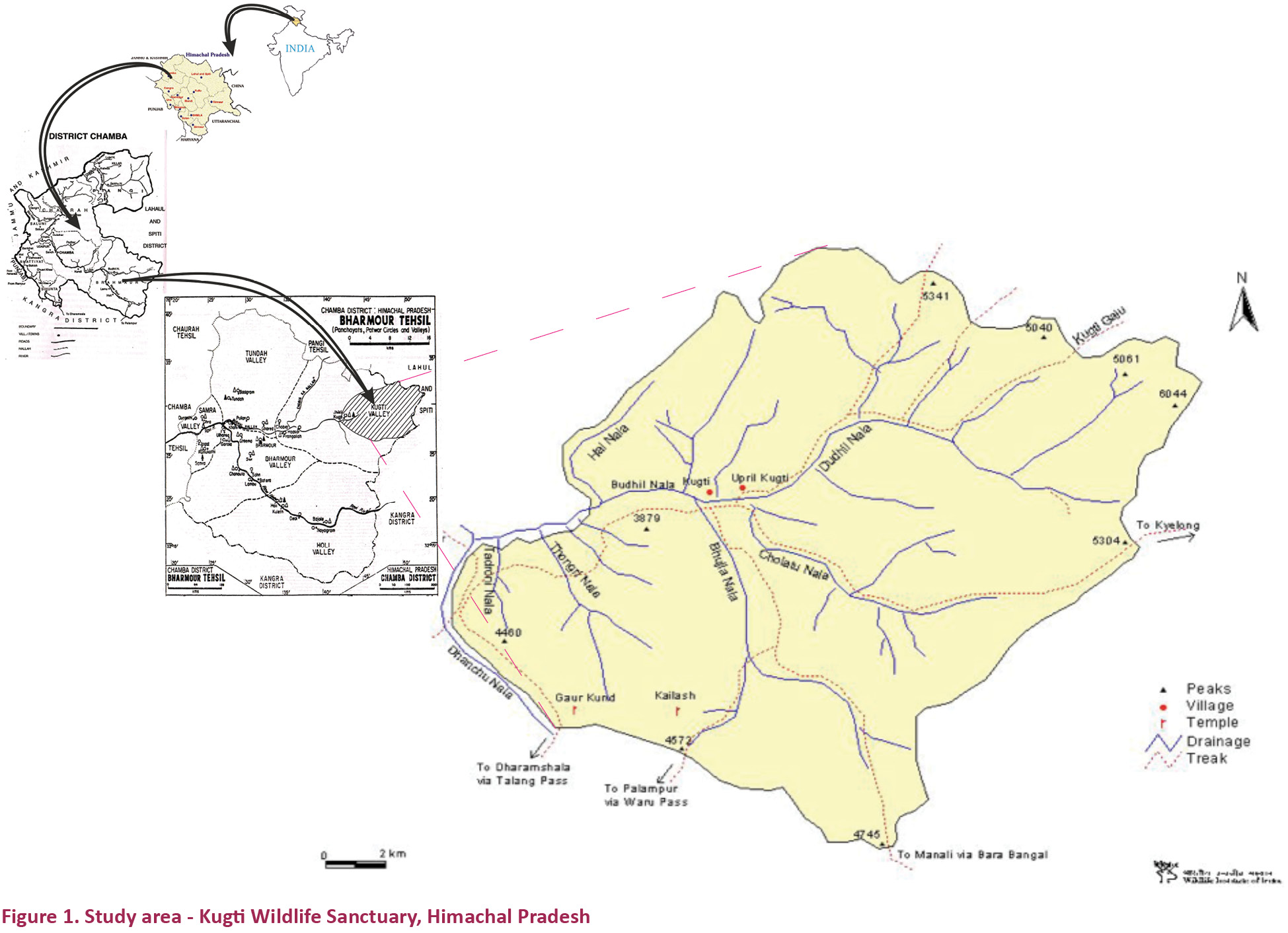
In Kugti Wildlife Sanctuary, eight distinct habitat types include: (i) agricultural land, grassland and forest blanks opening, (ii) mixed forest with conifers and broad leaf species, (iii) Himalayan moist temperate forests with conifers, (iv) along water bodies like river and streams, (v) dry alpine scrub characterized by Juniperus species, (vi) riverine forests, (vii) exposed rock with grassy slopes, and (viii) moist sub-alpine scrub dominated by Rhododendron species (Fig. 2). In addition to brown bears, other animal species in the study area are the Common Leopard Panthera pardus, Himalayan Tahr Hemitragus jemlahicus, Himalayan Musk Deer Moschus chrysogaster, Himalayan Ibex Capra ibex, Goral Nemorhaedus goral, Himalayan Grey Langur Semnopithecus ajax, Porcupine Hystrix indica and the Asiatic Black Bear Ursus thibetanus.
Methods
The Himalayan Brown Bear food habits were determined by analyzing scat samples, through direct observations of feeding activities and through the examination of specific feeding sites. Brown bears were seen actively feeding during the day. Diet composition and seasonal variation were studied between the years 2002 and 2004. Direct feeding observations were made 57 times. Each observation averaged 10-minute duration using 50X binoculars and visiting the feeding sites after each bear withdrew.
Fecal (scats) collection
From April 2002 to December 2004, 222 scats were collected from different parts of Kugti Wildlife Sanctuary, though a systematic collection technique was not feasible in the mountainous and often rugged terrain. Scats were mainly collected while walking along the 22 linear transects, 1km each. Scats were also collected from areas other than the transects. In the study areas, brown bears are the largest carnivores, so feces were identified easily on the basis of shape, appearance and diameter (mean diameter 3.9cm, <2.6cm and mostly black in color) (Image 1). Scat collection was most successful in November (n=46), December (n=44), August (n=36), and May (n=28) and least successful in April (n=9). Scats present at brown bear daybeds in open grazing pastures locally called ‘Gots’, were also collected (Image 2). Scats were separately placed in plastic bags and relevant details such as date of collection, location and location fixes were noted. Samples were air-dried in the field and then stored until analysis.
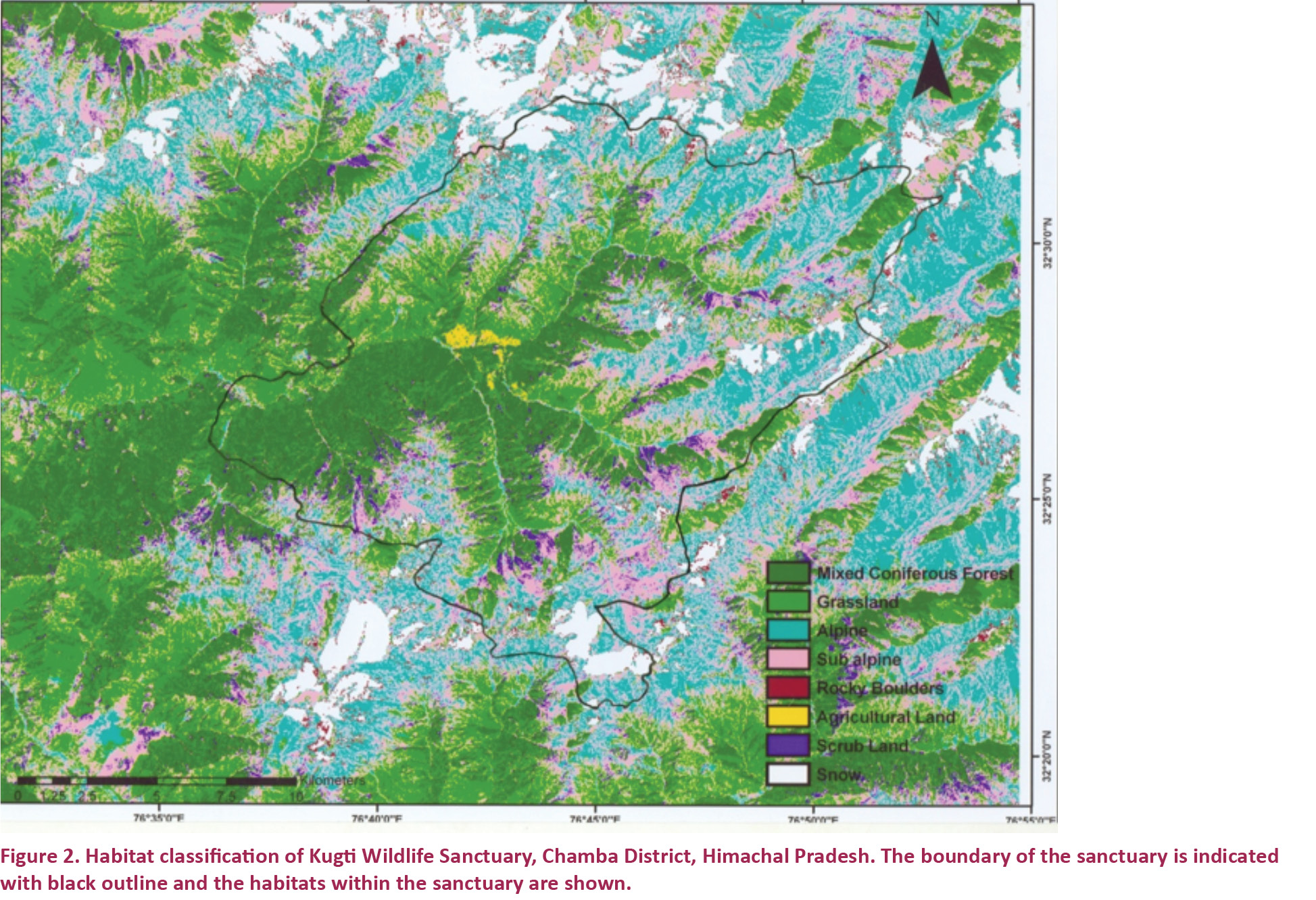
Fecal analysis
Bear scats were analyzed in the laboratory following the techniques described by Mealey (1980), Cicnjak et al. (1987), Ohdachi & Aoi (1987), MacHutchon & Wellwood (2003) and Bargali et al. (2004). Scats were weighed separately and only 10% of each scat was used for analysis. The sample was immersed in water for 10–15 hours. Samples were then rinsed thoroughly using sieves to separate fruit, vegetative and undigested material, and then suspended in water. Scat samples were also washed through 0.4mm and 0.7mm sieves. The remaining portions of scats were oven dried for 15–24 hours at 600C and then analyzed manually by separating different components such as hairs, bones, claws, teeth, fruits, seeds, ants, insect parts and plant matter. The plant matter was identified up to the species level using reference slides from previous collections of food plants. The dietary composition was estimated in terms of the frequency of food items in the scats and ocular estimate of their volume. Estimates of volume were assigned to one of the three categories: high (66.7–100 %), medium (33.4–66.6 %), or low (0–33.3 %).
Results
Dietary composition
Both plant and animal matter were found in the diet of the brown bear in all the seasons (summer n=72, monsoon n=69, and fall n=81). The frequency of plant matter (79%) was higher than animal matter (21%) for all seasons (Fig. 3). Animal matter comprised insects, ants and unknown items including hairs, bones, jaws, teeth and claws in the bear diet (Table 1, Fig. 4). The frequency of ant and other insect parts was 9.3% and 5.2% respectively, and the frequency of hairs was 2.9%, bone 2.3%, jaws and teeth 0.6%, and claws 0.6%. Plant matter comprised 10 plant species, but also included 58.3% unknown plant material. Known species included seeds of Prunus persica, Prunus cornuta, fruits of Rhamnus virgatus, Viburnum cotinifolium and Berberis aristata, and Guchhi Mushroom Morchella esculenta. Scats also contained 7.2% cultivated species such as wheat Triticum aestivum, jau Hordeum vulgare, ‘bharesh’ Fagopyrum esculentum, ‘phullan’ Fagopyrum emarginatum, maize Zea mays, and fruits of aru Prunus spersica, jammu Prunus cornuta, kamulu Berberis aristata, Rhamnus virgatus and Viburnum cotinifolium, and a high amount of herbaceous matter found in the study area. Ocular estimates were high for plant matter (66.7–100 %), a medium for insects and ants (33.4–66.6 %) and low for remaining animal and plant matter (0–33.3 %).
Based on 57 direct observations of foraging bears made from 2002–2004, brown bears were found feeding on 29 species of plants including agricultural crops (Fig. 5). They were found feeding on Rumex nepalensis after emerging from hibernation. Image 3 shows Himalayan Brown Bear foraging on Rumex nepalensis in Kugti Wildlife Sanctuary. Image 4 shows female Himalayan brown bear with two cubs in Rhododendron patch. Other food plants/items such as Impatiens scabrida, Taraxacum officinale, Geranium pratens, Gegea elegans, Potentilla argyrophylla, Stellaria media, Stachys melissaefolia and Geum elatum were also preferred by the bears.
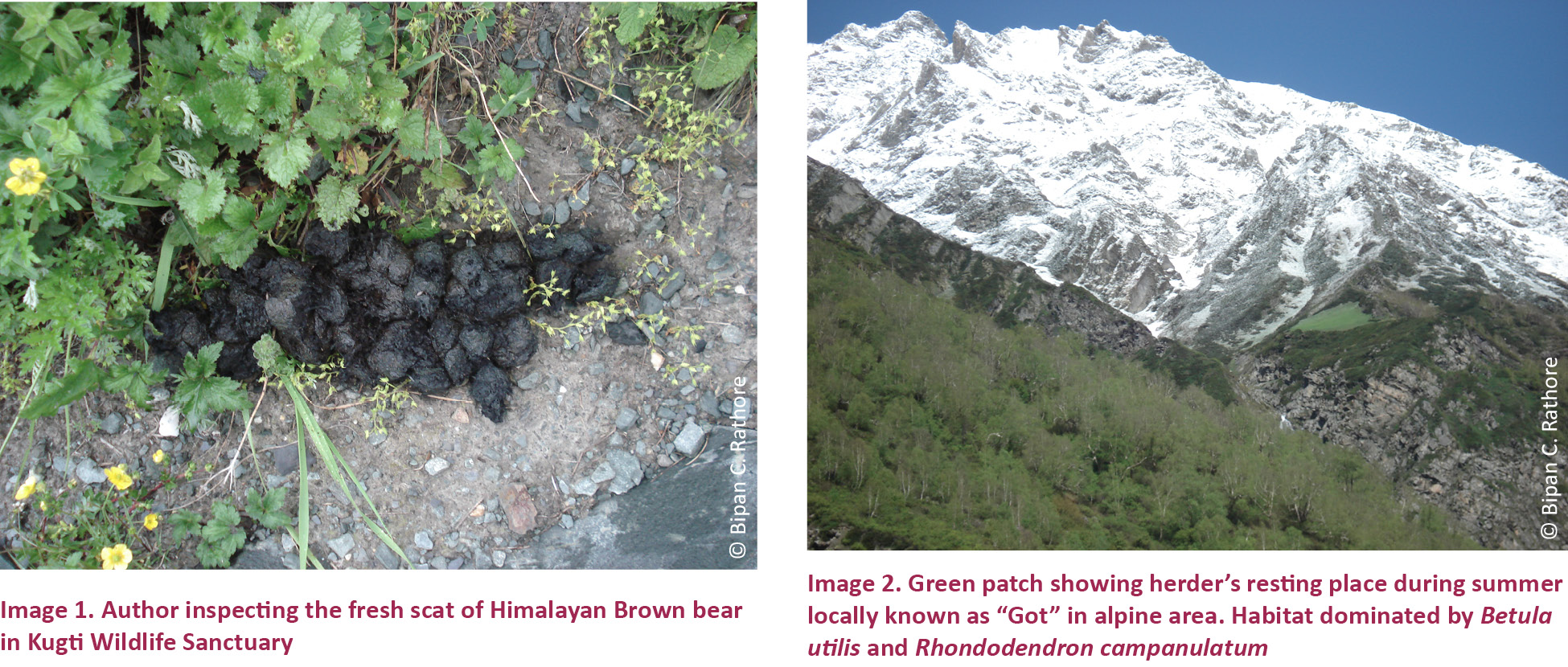
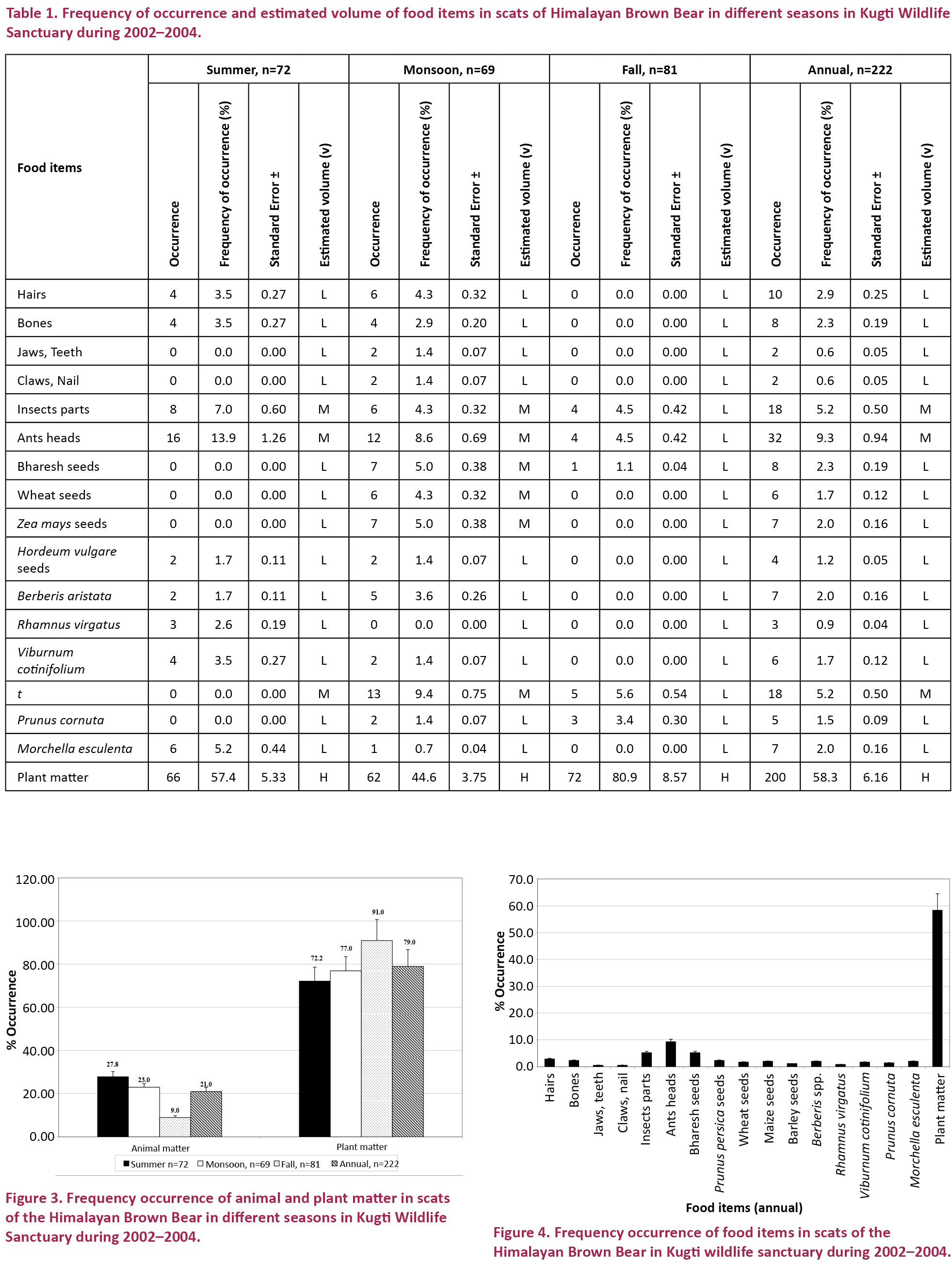
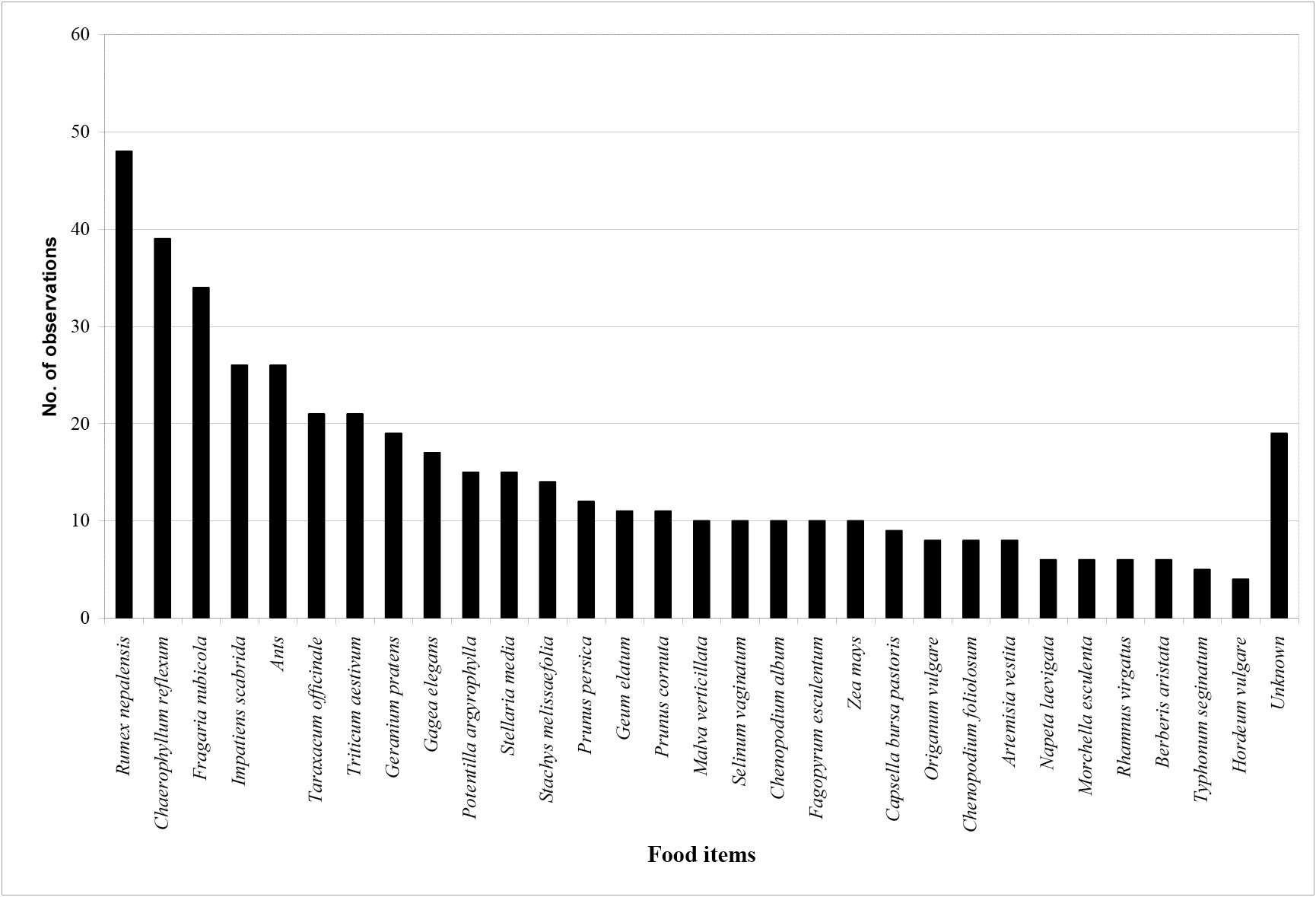

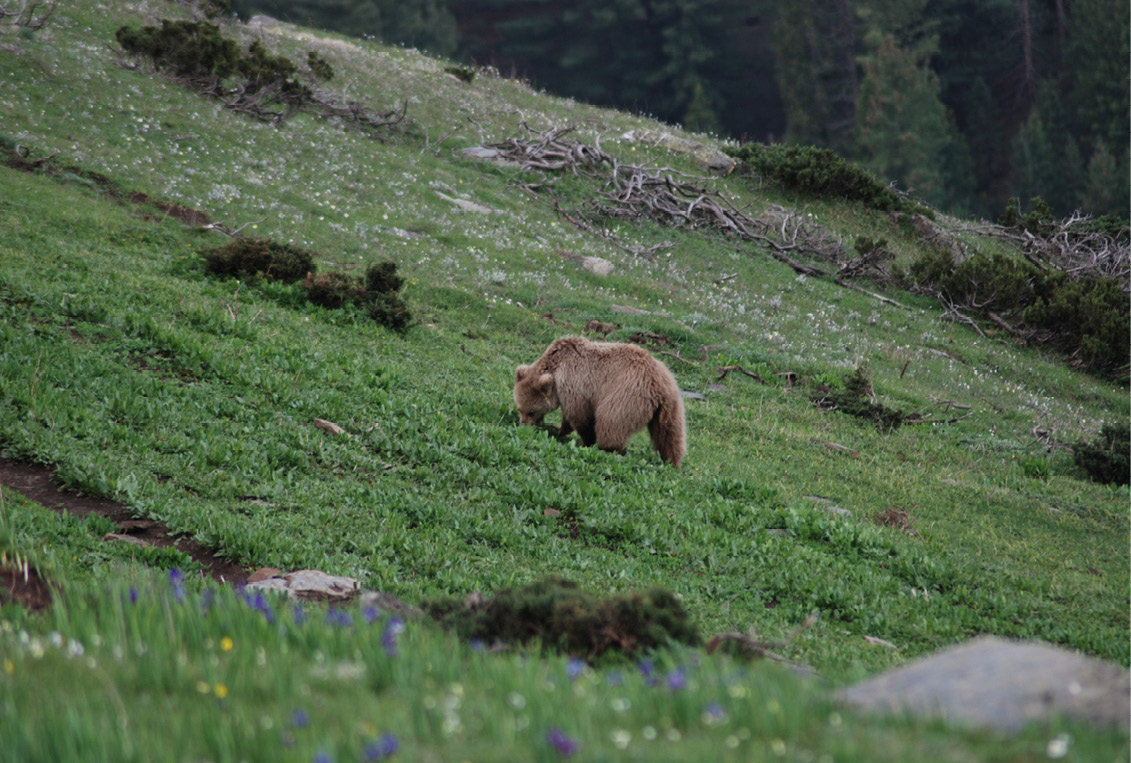

Seasonal diet
Both plant and animal matter comprised a part of the bears’ diet throughout the year. Amongst the 15 plant and animal food items, an overall annual frequency occurrence of plant matter was highest (58.3%, Table 1, Fig. 4). The diet comprised five plant species during the summer season, nine plant species during the monsoon season and only three species during the fall. A large part of the scats comprised unknown plant matter. Animal matter in the brown bear diet comprised eight different animal species during both summer and monsoon seasons, whereas no animal matter was found in scats during the fall season (Table 1).
The frequency of occurrence of animal matter was highest in summer 27.9%, followed by 22.9% in monsoon and 9% in fall (Table 1). During summer, hairs and bones constituted 7%, and insect parts and ants constituted 20.9%. Hairs, bones, jaws, teeth, claws and nails constituted 10% of the animal matter during monsoon, and insect parts and ants were 12.9%. There was no animal matter found in the scat of brown bear during fall, except for insect and ants, which constituted 9%. Among the plant matter, the frequency of occurrence of unknown plant matter was found to be the highest in the scats during fall (80.9%), followed by summer (57.4%) and monsoon (44.6%, Table 1). The estimated volume for unknown plant matter was also high in all the seasons. Fruits of Prunus persica, Prunus cornuta, Rhamnus virgatus, Viburnum cotinifolium and Berberis aristata had a frequency of occurrence of 7.8%, 15.8% and 9% during summer, monsoon, and fall, respectively. The frequency of occurrence of agricultural crops was found to be the highest (15.7%) during monsoon, followed by summer (1.7%) and fall (1.1%). The annual frequency of occurrence of agricultural crops was found to be 7.2%. Morchella esculenta was consumed more by the brown bear during summer (5.2%) than during the monsoon season (0.7%). However, the estimated volume for this fungus was low in all seasons.
Using a one way ANOVA it was found that the bear’s diet was considerably different between monsoon and fall seasons (Fcrit=4.17, df=1, p=0.0011), and there was no significant difference between the bear diet during summer and monsoon seasons (Fcrit=4.17, df=1, p=0.226). Figure 6 illustrates a marked monthly variation in the occurrence of different food items in scats of brown bear. Plant matter occurred in the scats from April to December. Wheat was found in most of the scats during summer and fall, and seeds of Fagopyrum esculentum were found in the scats during August, September and October. Morchella esculenta was also recorded in scats during April, May, June and September. Zea mays seeds were found in the scats during August and September. Prunus persica seeds were found in the during September. Availability of most of the food items of brown bear was between March and October months. Food plants: Capsella bursa pastoris, Chenopodium album, Fragaria nubicola, Rumex nepalensis and Taraxacum officinale were available throughout March/April to September/October. Chaerophyllum reflexum, Napeta laevigata, Origanum vulgare, Potentilla argyrophylla, Impatiens scabrida, Stachys melissaefolia, Stellaria media and Typhonum seginatum were also available as food plants during May to September (Table 2, Fig. 6).
Discussion
While we can determine the frequency of feeding or presence of certain food items in bear scats, we cannot determine the quantity of food items consumed. Clearly, the frequency of feeding was dependent on the availability of varied types of food material in a particular area. Additionally, frequent consumption of small quantities show a high occurrence of the species in the scats, indicating a higher percent occurrence of food items in the diet (Desai et al. 1997).
Results from various studies conducted on food habits elsewhere were comparable with our findings. The food habits of brown bears in Plitvice Lake National Park, Yugoslavia were studied and plant matter was found in 76% of the samples, whereas 24% contained both plant and animal matter (Cicnjak et al. 1987). Grizzly Bear Ursus arctos horribilis were found to consume Apples Malus spp. and Plums Prunus spp. in Montana (Mace & Jonkel 1986). Grasses and sedges were a staple food for bears, and horsetails, Clover Trifolium spp. and Dandelions Taraxcum spp. were also important. Food habits of brown bear were studied in the Bieszczady Mountains in Polish eastern Carpathians and the results indicated that grasses and unidentified plants species constituted a very significant part of bear diet in summer (Frackowiak 1997). A study on the food habits of Grizzly Bear in the Firth River Valley, Ivvavik National Park, northern Yukon, Canada revealed that in spring, the primary Grizzly Bear food plants were Alpine Hedyserum Hedysarum alpinum roots and main food plants in summer were Common Horsetail Equisetum arvense and Bearflower Boykinia richardsonii, (MacHutchon & Wellwood 2003).
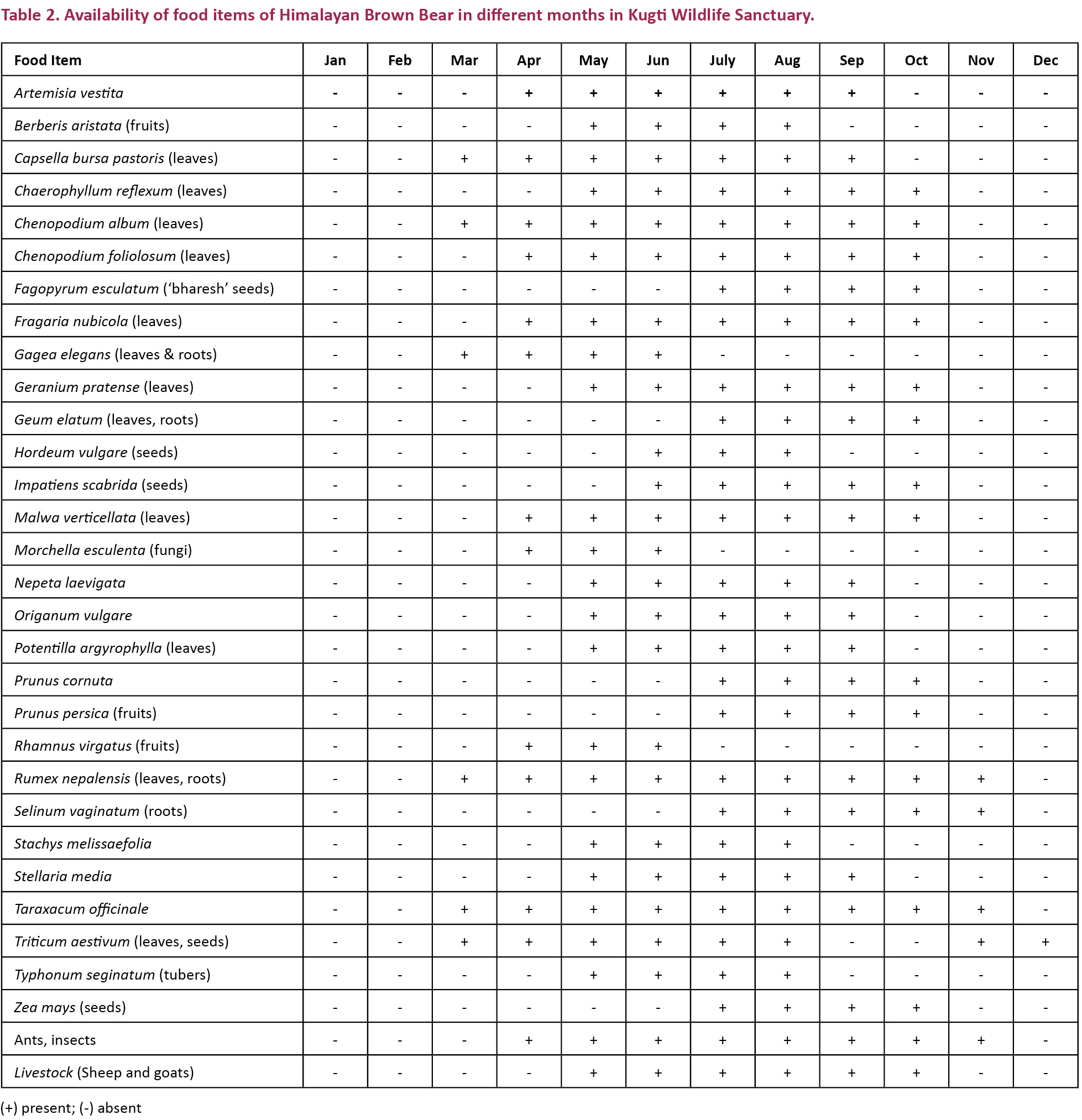
Grizzly Bears consume herbaceous vegetation commonly during spring and early summer in many ecosystems. Even in areas with abundant meat and fish resources, grasses, forbs and sedges comprise a major part of the bear diet in spring and early summer (LeFrance et al. 1987). Their findings are consistent with what we found in Kugti Wildlife Sanctuary where brown bears were found to extensively dig up the soil for feeding on grasses, forbs, and roots, and consume animal matter such as ants and livestock, particularly sheep and goats.
Our results were similar to those found in the studies of Mealey (1980), Servheen (1983), Mace & Jonkel (1986), Cicnjak et al. (1987), Ohdachi & Aoi (1987) and Hamer & Herrero (1987). According to Ohdachi & Aoi (1987), ants (formicidae) were the most abundant animal material. Observations of diggings and stoneturning in alpine and sub-alpine zones in our study area suggested that ants and insects are important food items for brown bears.
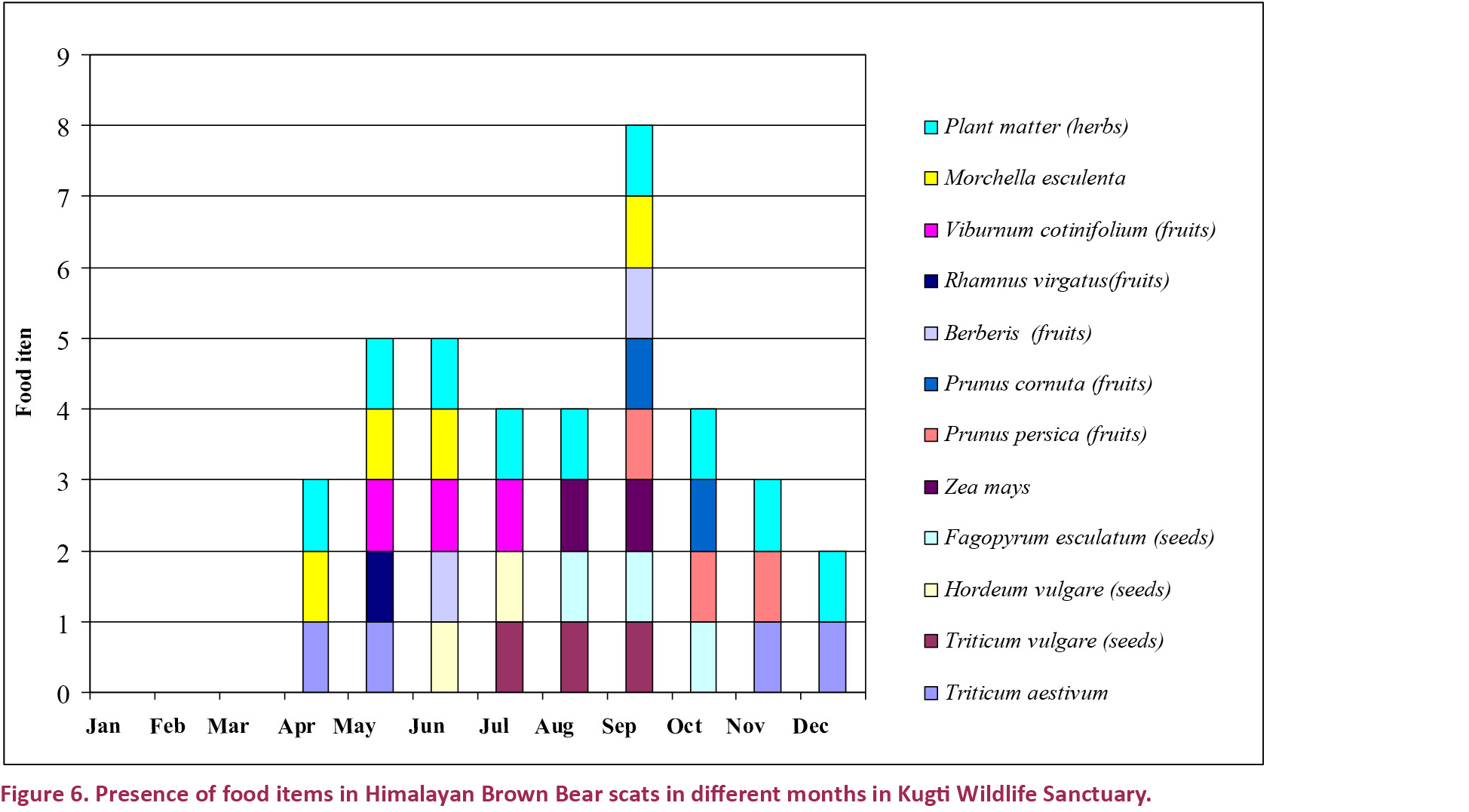
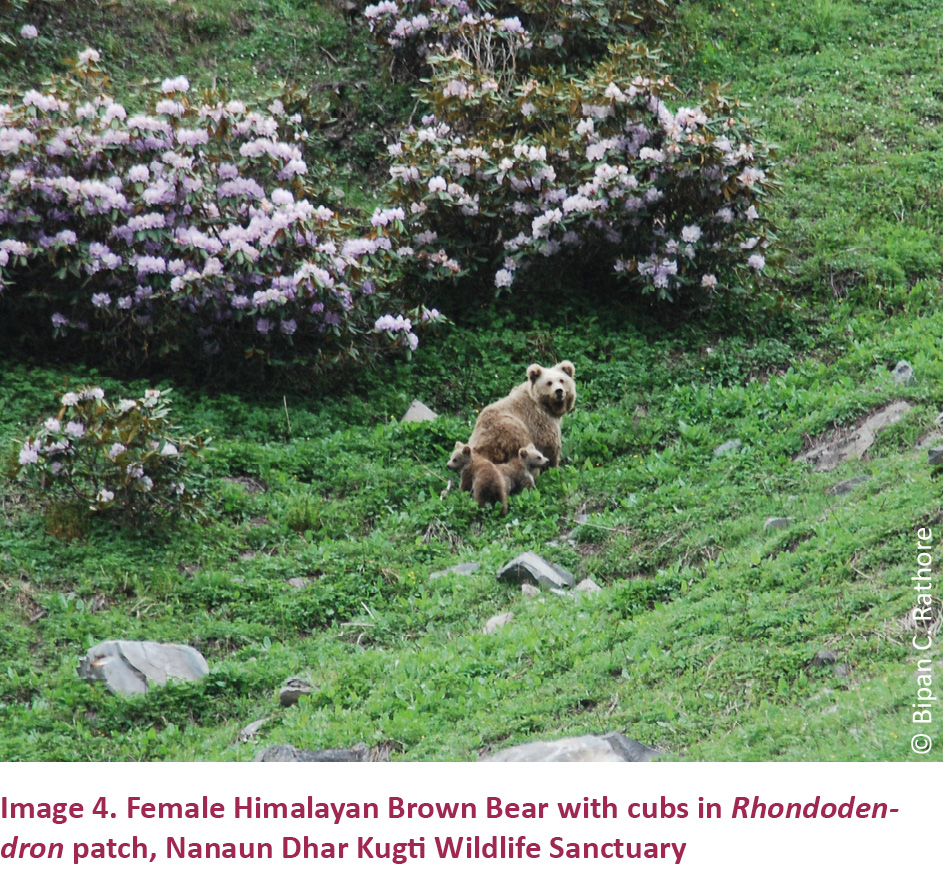
The higher occurrence of plant matter in bear diets during all seasons could be due to the availability of preferred herbaceous plants in the study area. Presence of wheat leaves in the scats indicated that bears switched to new food sources when herbaceous plants diminished in October.
Presence of wheat Triticum aestivum, maize, ‘jau’ Hordeum vulgare, and ‘bharesh’ Fagopyrum esculentum seeds in the brown bear scats in Kugti Wildlife Sanctuary indicated that when availability of other plants was scarce, the dependency of bears on alternative food resources increased and bears opted to raid crops in agricultural fields located far away from Kugti Village and closer to forests. Our study also showed the presence of Morchella esculenta during summer and monsoon, which is similar to results of a study on food habits of brown bears in four diverse areas in Hokkaido, Japan (Ohdachi & Aoi 1987).
Our study on food habits suggests that brown bears of Kugti Wildlife Sanctuary are largely herbivorous. According to our results, herbaceous plants found in sanctuary areas are a major food source for bears in all seasons, along with high altitude agricultural crops.
Management Recommendations
The brown bear in Kugti Wildlife Sanctuary faces biotic interferences due to excessive livestock grazing. These activities should be evaluated to determine the possible impact on the habitat use and movement of brown bears in these areas.
The growth in numbers of livestock (sheep and goats) and increasing dependency on alpine pastures is the major threat to bears, and increasingly generates human-bear conflicts as livestock are preyed upon by brown bears in alpine pastures from May to October. Therefore, there is a need for planning strategies for conflict mitigation, and regulation of livestock grazing in the highly preferred habitat use areas. Public awareness regarding the natural history and behaviour of the brown bear is necessary for local people.
References
Bargali, H.S., N. Akhtar & N.P.S. Chauhan (2004). Feeding ecology of Sloth Bears in a disturbed area in central India. Ursus 15(2): 212–217; http://dx.doi.org/10.2192/1537-6176(2004)015<0212:FEOSBI>2.0.CO;2
Bunnell, F.L. & A.N. Hamilton (1983). Forage digestibility and fitness in Grizzly Bears. International Conference on Bear Research and Management (5): 179–185.
Cicnjak, L., D. Huber, H.U. Roth, R.L. Ruff & Z. Vinovrski (1987). Food habits of Brown Bears in Plitvice Lakes National Park, Yugoslavia.International Conference on Bear Research and Management (7): 221–226.
Clevenger, A.P., F.J. Purroy & M.R. Pelton (1992). Food habits of Brown Bears (Ursus arctos) in the Cantabrian Mountains, Spain.Journal of Mammology (73): 415–421.
Dahle, B., O.J. Sorenson, E.H. Wedul, J.E. Swenson & F. Sandegren (1998). The diet of Brown Bears Ursus arctos in central Scandinavia: effect of access to free-ranging domestic sheep Ovis aries. Wildlife Biology 4(3): 147–158.
Desai, A.A., N. Baskaran & S. Venkatesh (1997). Behavioural ecology of the Sloth Bear in Mudumalai Wildlife Sanctuary and National Park, Tamil Nadu. Final Project Report. Bombay Natural History Society and Tamil Nadu Forest Department.
Frackowiak, W. (1997). Diet and food habits of the Brown Bear (Ursus arctos L.) in polish eastern Carpathians. Journal Wildlife Research 2(2): 154–160.
Hamer, D. & S. Herrero (1987). Grizzly Bear food and habitat use in the front ranges of Baniff National Park, Alberta. International Conference of Bear Research and Management 7: 199–213.
Hechtel, J.L. (1985). Activity and food habits of barren ground Grizzly Bears in Arctic Alaska. Thesis. University of Montana, Missoula, Montana, USA.
Hewitt, D.G. & C.T. Robbins (1996). Estimating Grizzly Bear food habits from fecal analysis. Wildlife Society Bulletin 24: 547–550.
Hilderbrand, G.V., C.C. Schwartz, C.T. Robbins, M.E. Jacoby, T.A. Hanley, S.M. Arthur & C. Servheen (1999b). The importance of meat, particularly salmon, to body size, population productivity, and conservation of North American Brown Bears. Canadian Journal of Zoology 77(1): 132–138; http://dx.doi.org/10.1139/z98-195
LeFranc, M.N., Jr. M.B. Moss, K.A. Patnode & W.C. Sugg (1987). Grizzly Bear compendium. Interagency Grizzly Bear Committee, Washington, DC, USA.
Mace, R.D. & C. Jonkal (1986). Local food habits of Grizzly Bear in Montana. International Conferenceon Bear Research and Management 6: 105–110.
MacHutchon, A.G. & D.W. Wellwood (2003). Grizzly Bear food habits in the northern Yukon, Canada. Ursus 14(2): 225–235.
Mattson, D.J., B.M. Blanchard & R.R. Knight (1991). Food habits of Yellowstone Grizzly Bears, 1977–1987. Canadian Journal of Zoology 69: 1619–1629.
Mealey, S.P. (1980). The natural food habits of Grizzly Bears in Yellowstone National Park 1973–74. International Conference on Bear Research and Management 4: 281–292.
Ohdachi, S. & T. Aoi (1987). Food habits of brown bears in Hokkaido, Japan. International Conference on Bear Research And Management 7: 215–220.
Rode, K.D. & C.T. Robbins (2000). Why bears consume mixed diets during fruit abundance. Canadian Journal of Zoology 78(9): 1640–1645; http://dx.doi.org/10.1139/z00-082
Sathyakumar, S. (1999). Status and Management of the Himalayan Brown Bear in India. Pp. 125-128 in Bears: Status survey and Conservation Action Plan. Servheen et al (editors), op. cit.
Servheen, C. (1983). Grizzly bear Food habits, Movements, And Habitat Selection in the Mission Mountains, Montana.Journal of Wildlife Management 47(4): 1026-1035.
Welch, C.A., J. Keay, K.C. Kendall & C.T. Robbins (1997). Constraints on frugivory by bears.Ecology 78: 1105-1119.
Xu, A., Z. Jiang, C. Li, J. Guo, G. Wu & P. Cai (2006). Summer food habits of brown bears in Kekexili Nature Reserve, Qinghai-Tibetan plateau, China. Ursus 17(2): 132–137; http://dx.doi.org/10.2192/1537-6176(2006)17[132:SFHOBB]2.0.CO;2